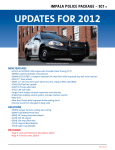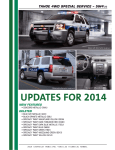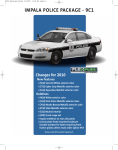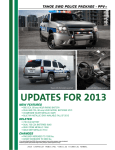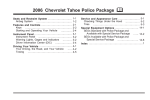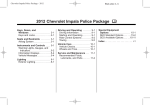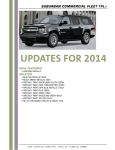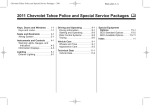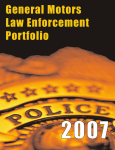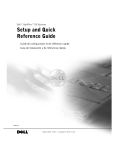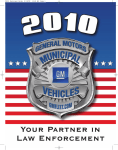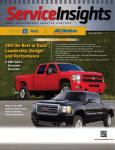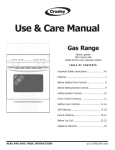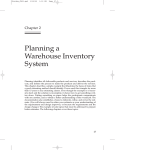Download Chevrolet Impala 2014 Owner`s manual
Transcript
Impala Limited Police Package 9C1 | 1 Shown with aftermarket equipment Shown with aftermarket equipment Updates for 2014 New Features • Carry Over content with new name "Impala Limited" Deleted • Victory Red exterior paint (74U) 2014 Chevrolet Municipal Vehicles Technical Manual 2 | Impala Limited Police Package 9C1 This vehicle has been designed for police work up to and including high speed emergency vehicle operations. GM restricts the sale of police vehicles and they are not to be sold to retail customers. Some standard equipment may be replaced by special equipment when the Police Package 9C1 is ordered MODEL AVAILABILITY 1ws19 Front-wheel drive Warranty 3 years / 36,000 mile bumper-to-bumper (whichever comes first, see dealer for details) 5 years / 100,000 mile limited powertrain (whichever comes first, see dealer for details) STANDARD EQUIPMENT SUMMARY INTERIOR FEATURES AIR CONDITIONING Single-zone manual, with air filtration and environmentally friendly refrigerant r134a Bluetooth Not available Cruise Control Electronic with set and resume speed Cup Holder Cup holder with storage tray between seats DOME Lamps Auxiliary, interior, sustained illumination. Floor Covering Carpeting front and rear (carpeted mats are available; see option b34 on page 9) GLASS Tinted windshield, backlight and side glass GLove box Non-locking without light MIRRORS, VISOR Visor, left hand and right hand with covered vanity mirrors MIRROR, REARVIEW Inside rearview is manual day night with driver and passenger map lamps Navigation System Not available OnStar Not available RADIOElectronically tuned am/fm stereo with cd player, seek-scan, digital clock, auto-tone control, theftlock with integrated rear window antenna (radio delete is not available) RESTRAINT SYSTEM Safety belts, driver and front passenger with pretensioners, dual stage driver and passenger frontal air bags1, passenger sensing system and frontal air bag1 ON/OFF indicator, dual head curtain air bags1 for front and rear outboard occupants and front seat back mounted thorax-pelvic air bags1 SEAT, FRONTHigh density foam cloth bucket seats with seat back security panel, 6-way power driver and passenger seat adjusters (see page 4) and manual reclining seat backs. Driver seat has manual lumbar control. Front seat frames are strengthened for side impact resistance (see page 17) SEAT, REAR Vinyl bench with high density foam non-folding seat back (see page 4) SMOKER'S PACKAGE Not available SPEEDOMETER/Cluster140 mph certified analog speedometer, 5 mph increments with digital trip odometer and warning lamps. Driver Information Center includes 1 mph redundant digital speed display (see message center listing on page 15) STEALTH MODE See exterior lamps control on page 17 for operation description STEERING WHEEL Tilt-wheel with column mounted gear shift lever Theft Deterrent System Vehicle PASS-Key® III+, content theft deterrent is disabled (to enable content theft deterrent option ua6 must be ordered) Trunk mat Heavy-duty (see page 17) WARNING LAMPS Brake, safety belt, air bag1, anti-lock brake, check engine (see page 14 for additional information) Warning Tones Key-in-ignition, driver door open, driver and passenger safety belt not buckled, headlamps on WINDOW OPERATION Power with driver express down, rear window lockout switch Auxiliary Power, Front Electrical Features 1 00-amp ignition and main power supply wiring under lower right side of instrument panel (see wiring provisions for 12-volt battery power supply on page 16) Auxiliary Power, Trunk 100-amp auxiliary power outlet in trunk (see page 16) Ground Stud Auxiliary, located in trunk (see page 16) LOCK-OUT PROTECTIONNot available, driver door can be locked with the key in the ignition. Lock-out protection feature cannot be activated POWER OUTLETS Two 12 volt, 20 amp, located on lower center of instrument panel. Battery power is present at all times Wiring Diagrams See pages 23 through 25 for description; also see Impala Police Package owner’s manual supplement (located in glove box folder with standard owner’s manual) Wiring Provision, EXTerior Lamps Flashing Forward lamp harness in-line connector for Exterior Lamp Flashing System (see option 6j7 on page 9) 1. Head curtain side air bags are designed to help reduce the risk of head and neck injuries to front and rear seat occupants on the near side of certain side-impact collisions. Always use safety belts and the correct child restraints for your child’s age and size, even in vehicles equipped with air bags. Children are safer when properly secured in a rear seat. See your vehicle Owner’s Manual and child safety seat instructions for more information. 2014 Chevrolet Municipal Vehicles Technical Manual Impala Limited Police Package 9C1 | 3 EXTERIOR FEATURES Body PanelsTwo-sided galvanized steel for all exterior body panels (except roof where not needed) Body Side MoldingsOptional (See option B86 on page 9) DEFOGGER Electric, rear window DOOR LOCKSPower non-programmable (automatic door locking and unlocking feature is disabled), child safety locks in rear doors. Driver door lock key cylinder only; key lock cylinder is not available in the front passenger door HeadlampsDual halogen composite, includes flash-to-pass feature and automatic lamps control with daytime running lamps (to delete automatic control, see option 9G8 on page 9 and exterior lamps control on page 17) HORNS Dual note Keyless Entry Includes two transmitters with non-functional panic button; the keyless entry system used on the police Impala includes a stealth mode feature. When the “unlock” or “lock” button is depressed, no exterior lamps or audible sounds are activated; however, the interior OEM dome lamp will illuminate unless option 7Y6 lamps, Inoperative Dome and Courtesy Lamps is ordered; during remote start feature, running lamps will remain illuminated (additional transmitters are available; see option AMF on page 9) KeysTwo-sided, random code, for ignition, driver door and trunk only; single key locking system to operate entire fleet is available (fleet coded single key is available; see 6E2 and 6E8 option on page 9) License PlateMounting hardware located in glove box; front bracket standard in states requiring front license plates; others must order option vk3 MIRRORS, Rearview Body color, electric Left hand and right hand remote (heated mirrors are available; see option DK2 on page 9) PAINT Base coat/clear coat TRUNK LAMP Standard TRUNK RELEASE Electric, ignition controlled, button located on left side of instrument panel, (ignition control release is available; see option a98 on page 9) UNDER HOOD LAMP Not available WINDSHIELD WIPERS Intermittent, anti-lift with washer CHASSIS FEATURES Alternator 170-amp with idle boost (transmission in park or neutral) controlled by battery energy level sensing Battery 720 CCA 70-amp hour with battery rundown protection (does not protect customer installed equipment) BODY Body frame intergal (unibody) Heavy-duty reinforced body components BRAKES4-wheel anti-lock disc brakes with police calibration and heavy-duty front brake pads COOLING Heavy-duty (high capacity) with 225-watt fans and extended life coolant; coolant hoses are EPDM (ethylene-propylene-diene monomer) rubber; silicone hoses are not required (coolant is DEX-COOL good for 5 years/150,000 miles, protects from -34° F to +265° F and against rust and corrosion) (see also page 17) Chassis LubricationLubed-for-life chassis ENGINE 3.6L V6 DOHC SIDI (spark ignited direct injection) engine with with Variable Valve Timing (VVT) with FlexFuel2 (gas or E85 ethanol); includes wide open throttle air conditioning cut off (when overhead lamps, spotlamps, radio antennas, sirens, and other emergency equipment are installed, overall performance may be reduced) EXHAUST SYSTEM Stainless steel, single with dual outlets FUEL TANK capacity 17 gallon (64 liters) Oil Coolers Engine, transmission and power steering oil coolers: external air-to-oil (see page 17) Radio Suppression Extended life - iridium tip spark plugs and wires that are designed to reduce radio frequency noise levels which may affect communications equipment including operating frequencies in the 38-MHz to 58-MHz range. The Impala is designed with unibody construction, and multiple grounding points are provided for the vehicle electrical system. No additional ground straps are added for the Police Package StabiliTrak Stability enhancement system. An advanced computer controlled system that assists the driver with directional control of the vehicle in difficult driving conditions. Each time the vehicle is started, the StabiliTrak system is fully on. StabliliTrak can be controlled by a StabiliTrak button on the instrument panel located below the dimmer control on the headlamp switch (see page 17). The condition of the system is displayed by an instrument panel StabiliTrak indicator light and Driver Information Center (DIC) Messages. Push once, Performance Mode is active and Traction Control is off, push and hold five seconds Traction Control and StabiliTrak are off, push again and Traction Control and StabiliTrak are turned back on Starter Interrupt Prevents starter from engaging while the engine is running STEERING Power, rack and pinion Struts, Front Heavy-duty SUSPENSION4-wheel independent, firm ride and handling with increased ride height springs, heavy-duty front and rear stabilizer bars TIRES Goodyear P235/55R17 SBR blackwall, “W” rated with compact spare (full-size spare is available; see option RUF on page 9) TIRE PRESSURE MONITOR Check Tire Pressure will show on driver message center (see page 17 for description) Traction control Deactivated when Police Performance Mode is engaged TRANSMISSION 6-speed automatic, electronically-controlled transmission provides protection against over-revving the engine in low gear and a mechanical low gear blockout is not required; if a driver manually selects low gear and fails to manually upshift to high gear, the powertrain control module automatically protects the drivetrain. It can be manually shifted up and down with buttons located on steering wheel WHEELS 17" x 7.5" heavy-duty steel WHEEL Center Cap Chrome bolt-on metal 2. E85 is 85% ethanol and 15% gasoline. To see if there is an E85 station near you, go to www.gmaltfuel.com/e85-station-locator. 2014 Chevrolet Municipal Vehicles Technical Manual Impala Limited Police Package 9C1 4| POWERTRAIN ENGINE OPTION TYPE TRANSMISSION DISPLACEMENT CODE LITERS/CU. IN. LFX V6 3.6/217 EMISSIONS - FUEL OPTION AXLE TYPE OPTION RATIO SYSTEM CODE CODE 6T70 FlexFuel2 (gas or E85 MXO 6-speed F71 ethanol) auto. with OD 2.44 MUST BE SPECIFIED FE9 F ederal emissions. Use for ordering vehicles that will be registered in all states except California, Connecticut, Delaware, Maine, Maryland, Massachusetts, New Jersey, New York, Oregon, Pennsylvania, Rhode Island, Vermont and Washington State YF5 California emissions. Use for ordering vehicles that will be registered in California. NE1CT/ME/MD/MA/NJ/NY/OR/PA/RI/VT/WA emissions. Use for ordering vehicles that will be registered in Connecticut, Delaware, Maine, Maryland, Massachusetts, New Jersey, New York, Oregon, Pennsylvania, Rhode Island, Vermont or Washington State NB8 Required when option code FE9 “Federal emissions” is ordered for delivery to a dealer located in California, Connecticut, Delaware, Massachusetts, Maryland, New Jersey, New York, Oregon, Pennsylvania, Rhode Island and Washington State for a purchaser who will be registering the vehicle outside California, Connecticut, Maine, Maryland, Massachusetts, New Jersey, New York, Oregon, Pennsylvania, Rhode Island, Vermont and Washington State. NC7 Required when option code YF5 “CALIFORNIA EMISSIONS” or option code NE1 "CT/DE/ME/MD/MA/NJ/NM/NY/OR/PA/RI/VT/WA EMISSIONS" is ordered for delivery to a dealer located in any state except California, Connecticut, Delaware, Maine, Maryland, Massachusetts, New Jersey, New York, Oregon, Pennsylvania, Rhode Island, Vermont and Washington for a purchaser who will be registering the vehicle in one of these states or sold as permitted below under “EPA Policy on the Sale of California Emission Vehicles” NB9 Required when option code YF5 is ordered for delivery to a dealer located in Connecticut, Delaware, Maine, Maryland, Massachusetts, New Jersey, New York, Oregon, Pennsylvania, Rhode Island, Vermont and Washington. Required when option code NE1 is ordered for delivery to a dealer located in California. NOTE: T he 2014 Chevrolet Impala Police Patrol Vehicle with the 3.6L Engine (LFX) with Emission Option Codes FE9, NE1, and YF5 is certified to EPA Tier 2 Bin 4 standards and qualifies as ULEV (Ultra Low Emission Vehicle) under California Air Resources Board (CARB) requirements, meaning it is 50-state certified. Emission Standard: BIN4 EPA engine family or test group: EGMXJ03.6166 TIRES - SPEED RATED MANUFACTURER QUANTITY SIZE SPEED RATING TYPE Goodyear Four P235/55R17 SBR blackwall W All Season BW NOTE: • Compact spare is standard (full-size spare is available see option RUF on page 9) • Due to specific requirements for performance, durability and safety, gm recommends only the original equipment tire for replacement • Tire Plys = Tread: 2 Polyester, 2 Steel, 1 Nylon Sidewall: 2 Polyster Total 7 Ply • Do not use tire chains - See your Owner's Manual for more information. SEATS AND INTERIOR TRIM STANDARD OPTIONAL SEAT OPTIONS EBONY AR9 19G AR9 19E Front: Cloth buckets (power driver and passenger) Rear: Vinyl bench (non-folding seat back) Front: Cloth buckets (power driver and passenger) Rear: Cloth bench (non-folding seat back) AVAILABLE EXTERIOR COLORS 17U 41U 50U GLJ Silver Ice Metallic Black Summit White Ashen Gray Metallic NOTE: For special paint and paint schemes see page 12 through 14 Actual colors may vary 2. E85 is 85% ethanol and 15% gasoline. To see if there is an E85 station near you, go to www.gmaltfuel.com/e85-station-locator. 2014 Chevrolet Municipal Vehicles Technical Manual Impala Limited Undercover Police PKG 9c3 | 5 Updates for 2013 Shown with optional rear spoiler Updates for 2014 New Features • Carry Over Deleted • Victory Red exterior paint (74U) 2014 Chevrolet Municipal Vehicles Technical Manual 6 | Impala Limited Undercover Police PKG 9c3 This vehicle has been designed for police work up to and including high speed emergency vehicle operations. GM restricts the sale of police vehicles and they are not to be sold to retail customers. Some standard equipment may be replaced by special equipment when the Police Package 9C1 is ordered MODEL AVAILABILITY 1ws19 Front-wheel drive Warranty 3 years / 36,000 mile bumper-to-bumper (whichever comes first, see dealer for details) 5 years / 100,000 mile limited powertrain (whichever comes first, see dealer for details) STANDARD EQUIPMENT SUMMARY INTERIOR FEATURES Air conditioning Single-zone manual, with air filtration and environmentally friendly refrigerant r134a Bluetooth Not available Cruise control Electronic with set and resume speed Floor covering Carpeting front and rear (carpeted mats are available; see option b34 on page 9) Dome Lamps Auxiliary, interior, sustained illumination Glass Tinted, windshield, backlight and side glass GLove box Non-locking without light Mirrors, visor Visor, left hand and right hand with covered vanity mirrors Mirror, rearview Inside rearview is manual day night with driver and passenger map lamps Navigation System Not available OnStar Not available RadioElectronically tuned am/fm stereo with cd player, seek-scan, digital clock, auto-tone control, theftlock with integrated rear window antenna (radio delete is not available) RESTRAINT SYSTEM Safety belts, driver and front passenger with pretensioners, dual stage driver and passenger frontal air bags1, passenger sensing system and frontal air bag1 ON/OFF indicator, dual head curtain air bags1 for front and rear outboard occupants and front seat back mounted thoraxpelvic air bags1 Seat, front 40/20/40 splint-bench cloth seat with folding arm rest and cup holder, 6-way power driver seat with recliner and manual lumbar, 6-way power passenger seat with manual reclining seat back and strengthened front seat frames for side impact resistance (see page 17) Seat, rear Cloth bench with high density foam non-folding seat back (see page 8) Smoker's package Not available Speedometer/cluster 140 mph certified analog speedometer, 5 mph increments with digital trip odometer and warning lamps. Driver Information Center includes 1 mph redundant digital speed display (see message center listing on page 15) STEALTH MODE See exterior lamps control on page 17 for operation description Steering wheel Tilt-wheel with column mounted gear shift lever Theft deterrent System Vehicle PASS-Key® III+, content theft deterrent is disabled (to enable content theft deterrent option UA6 must be ordered) Trunk mat Heavy-duty (see page 17) Warning LAMPS Brake, safety belt, air bag1, anti-lock brake and check engine (see page 15 for additional information) Warning Tones Key-in-ignition, driver door open, driver and passenger safety belt not buckled, headlamps on Window Operation Power with driver express down, rear window lockout switch Electrical features Auxiliary power, front 1 00-amp ignition and main power supply wiring under lower right side of instrument panel (see wiring provisions for 12-volt battery power supply on page 16) Auxiliary power, trunk 100-amp auxiliary power outlet in trunk (see page 16) Ground stud Auxiliary, located in trunk (see page 16) LOCK-OUT PROTECTIONNot available, driver door can be locked with the key in the ignition. Lock-out protection feature cannot be activated Power outlets Two 12 volt, 20 amp, located on lower center of instrument panel. Battery power is present at all times Wiring diagrams See pages 23 through 25 for description; also see Impala Police Package owner’s manual supplement (located in glove box folder with standard owner’s manual) Wiring Provision, EXTerior Lamps Flashing Forward lamp harness in-line connector for Exterior Lamp Flashing System (see option 6j7 on page 9) 1. Head curtain side air bags are designed to help reduce the risk of head and neck injuries to front and rear seat occupants on the near side of certain side-impact collisions. Always use safety belts and the correct child restraints for your child’s age and size, even in vehicles equipped with air bags. Children are safer when properly secured in a rear seat. See your vehicle Owner’s Manual and child safety seat instructions for more information. 2014 Chevrolet Municipal Vehicles Technical Manual Impala Limited Undercover Police PKG 9c3 | 7 EXTERIOR FEATURES Body panels Two-sided galvanized steel for all exterior body panels (except roof where it is not needed) Body Side MoldingsOptional (See option B86 on page 9) Defogger Electric, rear window DOOR LOCKSPower non-programmable (automatic door locking and unlocking feature is disabled), child safety locks in rear doors. Driver door lock key cylinder only; key lock cylinder is not available in the front passenger door Headlamps Dual halogen composite, includes flash-to-pass feature and automatic lamp control with daytime running lamps (to delete automatic control, see option 9g8 on page 9 and exterior lamps control on page 17) Horns Dual note Keyless entry Includes two transmitters with non-functional panic button; the keyless entry system used on the police Impala includes a stealth mode feature. When the “unlock” or “lock” button is depressed, no exterior lamps or audible sounds are activated; however, the interior OEM dome lamp will illuminate unless option 7Y6 lamps, Inoperative Dome and Courtesy Lamps is ordered; during remote start feature, running lamps will remain illuminated (additional transmitters are available; see option AMF on page 9) Keys Two-sided, random code, for ignition, driver door and trunk only; single key locking system to operate entire fleet is available (fleet coded single key is available; see option 6e2 and 6e8 on page 9) License plateMounting hardware located in glove box; front bracket standard in states requiring front license plates; others must order option vk3 Mirrors, rearview Body color, electric left hand and right hand remote (heater mirrors are available; see option dk2 on page 9) Paint Base coat/clear coat TRUNK LAMP Standard Trunk release Electric (not ignition controlled), button located on instrument panel, left of steering column; manual inside trunk safety release (ignition control is available; see option A98 on page 9) UNDER HOOD LAMP Not available Windshield wipers Intermittent, anti-lift with washer Chassis features Alternator Battery Body Brakes Cooling 1 70-amp with idle boost (transmission in park or neutral) controlled by battery energy level sensing 720 CCA 70-amp hour with battery rundown protection (does not protect customer installed equipment) Body frame inergal (unibody) Heavy-duty reinforced body components Power 4-wheel anti-lock disc brakes with police calibration and heavy-duty front brake pads Heavy-duty (high capacity) with 225-watt fans and extended life coolant; coolant hoses are EPDM (ethylene-propylene-diene monomer) rubber; silicone hoses are not required (coolant is DEX-COOL good for 5 years/150,000 miles, protects from -34° F to +265° F and against rust and corrosion) (see also page 17) Chassis lubrication Lubed-for-life chassis ENGINE 3.6L V6 DOHC SIDI (spark ignited direct injection) engine with with Variable Valve Timing (VVT) with FlexFuel2 (gas or E85 ethanol); includes wide open throttle air conditioning cut off (when overhead lamps, spotlamps, radio antennas, sirens, and other emergency equipment are installed, overall performance may be reduced) Exhaust system Stainless steel, single with dual outlets Fuel tank capacity 17 gallon (64 liters) Oil coolers Engine, transmission and power steering oil coolers: external air-to-oil (see page 17) Radio suppressionExtended life - iridium tip spark plugs and wires that are designed to reduce radio frequency noise levels which may affect communications equipment including operating frequencies in the 38-MHz to 58-MHz range. The Impala is designed with unibody construction, and multiple grounding points are provided for the vehicle electrical system. No additional ground straps are added for the Police Package StabiliTrakStability enhancement system. An advanced computer controlled system that assists the driver with directional control of the vehicle in difficult driving conditions. Each time the vehicle is started, the StabiliTrak system is fully on. StabliliTrak can be controlled by a StabiliTrak button on the instrument panel located below the dimmer control on the headlamp switch (see page 17). The condition of the system is displayed by an instrument panel StabiliTrak indicator light and Driver Information Center (DIC) Messages. Push once, Performance Mode is active and Traction Control is off, push and hold five seconds Traction Control and StabiliTrak are off, push again and Traction Control and StabiliTrak are turned back on Starter interrupt Prevents starter from engaging while the engine is running Steering Power, rack and pinion Struts, front Heavy-duty Suspension4-wheel independent, firm ride and handling with increased ride height springs, heavy-duty front and rear stabilizer bars Tires Goodyear P235/55R17 SBR blackwall, “W” rated with compact spare (full-size spare is available; see option RUF on page 9) Tire pressure monitor check tire pressure will show on driver message center (see page 17 for description) Traction control Deactivated when Police Performance Mode is engaged Transmission 6-speed automatic, electronically-controlled transmission provides protection against over-revving the engine in low gear and a mechanical low gear blockout is not required; if a driver manually selects low gear and fails to manually upshift to high gear, the powertrain control module automatically protects the drivetrain. It can be manually shifted up and down with buttons located on steering wheel Wheels 17" x 7.5" heavy-duty steel Wheel covers Full-size plastic wheel covers 2. E85 is 85% ethanol and 15% gasoline. To see if there is an E85 station near you, go to www.gmaltfuel.com/e85-station-locator. 2014 Chevrolet Municipal Vehicles Technical Manual 8 | Impala Limited Undercover Police PKG 9c3 POWERTRAIN ENGINE OPTION TYPE TRANSMISSION DISPLACEMENT CODE LITERS/CU. IN. LFX V6 3.6/217 EMISSIONS - FUEL OPTION AXLE TYPE OPTION RATIO SYSTEM CODE CODE 6T70 FlexFuel2 (gas or E85 MXO 6-speed F71 ethanol) auto. with OD 2.44 MUST BE SPECIFIED FE9 F ederal emissions. Use for ordering vehicles that will be registered in all states except California, Connecticut, Maine, Maryland, Massachusetts, New Jersey, New York, Oregon, Pennsylvania, Rhode Island, Vermont and Washington State YF5 California emissions. Use for ordering vehicles that will be registered in California. NE1CT/ME/MD/MA/NJ/NY/OR/PA/RI/VT/WA emissions. Use for ordering vehicles that will be registered in Connecticut, Maine, Maryland, Massachusetts, New Jersey, New York, Oregon, Pennsylvania, Rhode Island, Vermont or Washington State NB8 Required when option code FE9 “Federal emissions” is ordered for delivery to a dealer located in California, Connecticut, Massachusetts, Maryland, New Jersey, New York, Oregon, Pennsylvania, Rhode Island and Washington State for a purchaser who will be registering the vehicle outside California, Connecticut, Maine, Maryland, Massachusetts, New Jersey, New York, Oregon, Pennsylvania, Rhode Island, Vermont and Washington State. NC7 Required when option code YF5 “CALIFORNIA EMISSIONS” or option code NE1 "CT/ME/MD/MA/NJ/NM/NY/OR/PA/RI/VT/WA EMISSIONS" is ordered for delivery to a dealer located in any state except California, Connecticut, Maine, Maryland, Massachusetts, New Jersey, New York, Oregon, Pennsylvania, Rhode Island, Vermont and Washington for a purchaser who will be registering the vehicle in one of these states or sold as permitted below under “EPA Policy on the Sale of California Emission Vehicles” NB9 Required when option code YF5 is ordered for delivery to a dealer located in Connecticut, Maine, Maryland, Massachusetts, New Jersey, New York, Oregon, Pennsylvania, Rhode Island, Vermont and Washington. Required when option code NE1 is ordered for delivery to a dealer located in California. NOTE: T he 2013 Chevrolet Impala Police Patrol Vehicle with the 3.6L Engine (LFX) with Emission Option Codes FE9, NE1, and YF5 is certified to EPA Tier 2 Bin 4 standards and qualifies as ULEV (Ultra Low Emission Vehicle) under California Air Resources Board (CARB) requirements, meaning it is 50-state certified. Emission Standard: BIN4 EPA engine family or test group: DGMXJ03.6166 TIRES - SPEED RATED MANUFACTURER QUANTITY SIZE SPEED RATING TYPE Goodyear 4 P235/55R17 SBR blackwall W All Season BW NOTE: • Compact spare is standard (full-size spare is available see option RUF on page 9) • Due to specific requirements for performance, durability and safety, gm recommends only the original equipment tire for replacement • Tire Plys = Tread: 2 Polyester, 2 Steel, 1 Nylon Sidewall: 2 Polyster Total 7 Ply • Do not use tire chains - See your Owner's Manual for more information. SEATS AND INTERIOR TRIM SEAT OPTIONS EBONY AN3 19C STANDARD Front Cloth 40/20/40 split-bench Rear: Cloth full bench (non-folding seat back) AVAILABLE EXTERIOR COLORS 17U 41U 50U GLJ Silver Ice Metallic Black Summit White Ashen Gray Metallic NOTE: For special paint and paint schemes see page 12 through 14 2. E85 is 85% ethanol and 15% gasoline. To see if there is an E85 station near you, go to www.gmaltfuel.com/e85-station-locator. 2014 Chevrolet Municipal Vehicles Technical Manual Actual colors may vary Impala Limited 9c1 & 9c3 - Options | 9 body side moldings - Body-color (installed on all 4 doors) CONTENT theft deterrent ALARM system - Requires ap3 remote start, unauthorized entry sounds horn and lamps flash delete daytime running lamps and automatic headlamps - Exterior lamps are operated manually (see page 17) flasher system, headlamps and tail lamps - drl compatible, headlamp flasher module with control wire and body control module rear lamp flashing (see page 19 for description) 6a3 Floor covering - Heavy-duty vinyl replaces production carpeting; carpeted mats not available (see page 22 for description) K05 heater - Engine block 6B7 hole in roof - On center line requires 6f5 wiring (not available with 6j5 hole) (see page 20 for description) 6J5 hole in roof - On passenger side requires 6f5 wiring (not available with 6b7 hole) (see page 20 for description) AMF Keyless entry transmitters - Fleet Package includes 6 additional transmitters. Transmitters are not programmed. Each transmitter, including the two standard with the vehicle, must be programmed together by a dealer at customer expense. Transmitter programming is not a warranty item. See you owner's manual supplement for programming information. (see also page 20 for customer programming of transmitters using the vehicles Driver Information Center procedure) NOTE: Vehicle specific, common fleet transmitter frequency not available 6e2 key common - Complete vehicle fleet, provides a single key with a specific code that is common to the door locks and ignition of all the vehicles in the vehicle fleet; key code is an alternate to SEO 6e8 key common, complete vehicle fleet; not compatible with 2005 and earlier Impalas, 2006 and earlier Tahoes and 2011 Caprice 6e8 key common - Complete vehicle fleet, provides a single key with a specific code that is common to the door locks and ignition of all the vehicles in the vehicle fleet; key code is an alternate to SEO 6e2 key common, complete vehicle fleet; not compatible with 2005 and earlier Impalas and 2006 and earlier Tahoes and 2011 Caprice 6C7 lamp - Red and white front auxiliary dome, separately switched (see page 18 for description) 7y6 lamp - Inoperative Dome and Courtesy Lamps (see page 18 for description) 6J6 lamps - Rear window auxiliary stop/turn signals (see page 19 for description) T53 lamps - Alternate flashing trunk lid warning (see page 19 for description) VK3 license plate bracket - Front (bracket standard for states requiring front license plate) B34 mats - Carpeted front and rear (not available with 6a3) DK2 mirrors - Heated outside rearview, power, body color 6N6 Rear door locks inoperative - Rear power locks are inoperable at rear doors but operate form drivers position (see page 22 for description) 6B2 Rear door handles inoperative - Doors can be opened only from outside (see page 22 for description) 6n5rear window switches inoperative - Rear door windows only operate from driver’s position (see page 22 for description) D81 rear spoiler AP3 remote vehicle starter system - Includes remote keyless entry (required with option UA6) 7X6 spotlamp - Left hand, separately fused (see page 20 for description) 7X7 spotlamps - Left and right hand, separately fused (see page 20 for description) 7X8 spotlamp provision - Left hand (see page 20 for description) 7X9 spotlamp provision - Left and right hand (see page 20 for description) RUF tire, spare - Full-size, includes non-programed Tire Pressure Monitor (see page 18 for description) A98 trunk release - Ignition controlled 6c8 wiring - Coaxial radio antenna cable - rg58 roof to trunk (see page 18) Wx7wiring - For customer connection to front door and windshield pillar speakers. Speakers are not connected to the vehicle radio; radio audio signals are routed to the rear speakers (see page 21 for description) 6j3 wiring - For grille lamps and speaker (see page 21 for description) 6J4 wiring - For horn/siren circuit, in-line connection for customer furnished switch (see page 21 for description) 6f5 wiring - Roof wires, requires 6b7 or 6j5 hole in roof, 2 number 10 awg wires only (see page 20 for description) B86 UA6 9g8 6J7 For standard and optional illustrations, see pages 15 through 22. Note: Factory installation of spotlamps and spotlamp provisions are recommended. Field installation of spotlamps must not interfere with proper deployment of the roof rail airbag in the event of a crash NOTE: Ship-through charge is included as part of base MSRP. 2014 Chevrolet Municipal Vehicles Technical Manual 10 | Impala Limited 9c1 & 9c3 Police PKG - Specs GENERAL ENGINE Model Drive 1WS19 2-wheel front EXTERIOR (in./mm) Wheelbase Overall length Overall width Overall height* Front track width Rear track width Turning diameter curb to curb (ft./m) Ground clearance* (lower control arm bolt) 110.5/2807 200.4/5090 72.9/1852 58.7/1491 62.4/1585 61.5/1562 38.0/11.6 6.46/164 Head room Shoulder room Hip room Leg room 39.4/1001 58.7/1491 56.4/1433 42.3/1074 Head room Shoulder room Hip room Leg room 37.8/960 58.6/1488 57.2/1453 37.6/955 LUGGAGE COMPARTMENT CAPACITY (cu. ft./liters) Luggage capacity3 (with space saver) EPA passenger compartment volume index3 18.6/526 104.8/2968 CITY/HIGHWAY/COMBINED 3.6L engine4 17/28/21 EPA label values, actual mileage will vary with options, driving conditions, driving habits and vehicle condition. ALTERNATOR SC3 170 77ºF (25ºC) KW7 Impala POLICE ALTERNATOR OUTPUT 200 190 3 180 77° F (25° C) 2 170 1 160 0 150 No Load Idle 625 140 221° F (105° C) 257° F 130 Automatic, electronically-controlled with overdrive Fluid pan removed & filter replaced (quarts/liters) AXLE Ratio (125° C) Type Size Type Size Park/Neutral 800 1000 1100 1200 Drive 800 800 800 800 3. Cargo and load capacity limited by weight and distribution. 4. EPA-estimated MPG. 5. Gross Vehicle Weight Rating (GVWR). When properly equipped, includes vehicle, passengers, cargo and equipment. 6. Maximum payload capacity includes weight of driver, passengers, optional equipment and cargo. 10. Curb weight in operational status with 100% fuel, fluids and standard base equipment (excludes optional content) * Published dimensions indicated are at curb weight Steel 17" x 7.5" CHASSIS Frame Engine cradle Front suspension Rear suspension Steering type Steering ratio (center) BATTERY 2000 All Season W-speed rated P235/55R17 WHEELS Type Bci group size Volts Amp hour rating Cold cranking-amps @ 0°F (-18°C) Reserve capacity @ 80°F (27°C) 100 Disc/Disc 246.3/1589.6 175.8/1134 422.1/65.5 12.7/323 10.9/277 1.2/30 .5/14 TIRES 110 Boost Level 0 1 2 3 2.44 ABS with vacuum boost Front - swept area (sq. in./sq. cm) Rear - swept area (sq. in./sq. cm) Total front and rear swept area (sq. in./sq. cm) Front rotor diameter (in./mm) Rear rotor diameter (in./mm) Front rotor thickness (in./mm) Rear rotor thickness (in./mm) 120 1000 6-speed 7.4/7.0 BRAKES REAR COMPARTMENT (in./mm) Type Amps V6 3.6/217 302/6800 262/5300 SIDI 11.5:1 Single with dual outlets 87 17.5/66.2 4.0/3.8 10.6/10.0 TRANSMISSION FRONT COMPARTMENT (in./mm) FUEL ECONOMY RATINGS Type Displacement: liters/cu. in. Horsepower/rpm Torque lb.-ft./rpm Induction system Compression ratio Exhaust Minimum recommended fuel octane Fuel tank capacity (gallons/liters) Oil with filter (quarts/liters) Cooling capacity (quarts/liters) Unitized body Aluminum Independent MacPherson Strut, coil spring over strut and stabilizer bar Independent Tri-Link MacPherson Strut, coil spring over strut and stabilizer bar Power rack and pinion 14.1:1 VEHICLE WEIGHT (lbs./kg.) GVWR5 Curb weight10 Payload6 (includes 5 passengers and space saver spare tire) Maintenance free 34 12 70 720 125 minutes 9C1 9C3 4938/2240 4938/2240 3736/1695 3743/1698 1140/517 1173/532 NOTE: See your vehicle tire and loading information label for specific weight values. See your owner's manual supplement for proper cargo loading distribution 2014 Chevrolet Municipal Vehicles Technical Manual Impala Limited 9c1 & 9c3 Police PKG - Dimensions | 11 IMPALA POLICE PACKAGE Front Side Glass 29” w x 15.5” h 58” 31” 27.5” Rear Qtr. Glass 12” w x 12” h Rear Side Glass 27.5” w x 15.5” h 40” 18” 39” 43” 28.5” 79.5” 200.5” Shown with optional body side moldings and rear spoiler 56” 40” 15” 84” 62.5” 42.5” 49” 80” Rear Window 50.5” w x 31.5” h Estimated material sizes to wrap: • Hood – 60” x 65” • Front Doors – 46” x 30” • Rear Doors – 43” x 32” • Roof – 87” x 48” • Trunk Lid – 36” x 53” 15” IMPALA 8” 49.5” 20” *Optional rear spoiler and bodyside moldings shown 2014 Chevrolet Municipal Vehicles Technical Manual 12 | Impala LIMITED 9c1 & 9c3 – Special Paint Available To accommodate customers who require special painted vehicles, orders will be sent to Kerr Industries who will special paint the cars once they are built. Please note: this ordering process is substantially different from the way special paint is ordered on other vehicle lines and requires an additional charge. See your local dealer for current pricing. It is recommended that the customer review the first vehicle painted when special paint is ordered, however it is not mandatory. If the customer chooses not to review a pilot vehicle, Kerr Industries will require sign off by the customer before the vehicle will be released. Customer and dealer costs associated with accommodations and travel for in person review of special paint are the responsibility of the dealer. To Order Special Paint • RPO White 50u or RPO Black 41u must be ordered • T he 4-digit special paint code in paint code 1/paint code 2 fields will be replaced by options denoting code 1 and code 2 colors • Paint scheme codes will be replaced by options • Solid color option is aas • 2-tone color option is aat • W hen special paint schemes are ordered only class A surfaces will be painted; mirrors and handles are NOT painted. For additional costs to have the handles and mirrors painted please contact Kerr Industries at 905-725-6561. • It is recommended that all vehicles be ordered in Black 41u before special paint is applied. • For paint colors not listed in this brochure please contact Kerr Industries directly at 905-725-6561 Example for Ordering Special Paint: If a dealer wants a Silver and Blue car with scheme w002, order 50u or 41u (White or Black rPO paint), options Bep (code 1 Blue), bfr (code 2 Silver), 1pb (paint scheme w002) and aat (2-tone paint) Special Paint Warranty • Warranty claims for special paints must be directed to Kerr Industries at 905-725-6561 After you have ordered special paint • A fter the vehicles have been ordered for special paint, kerr Industries will contact the dealer directly regarding colors and verification of the scheme. Once verified a special paint build sheet will be sent to the dealer for final confirmation. This sheet will need to be signed by the dealer and returned to kerr Industries before painting will commence. NOTE: T he attached list of paint options contain the same WA numbers in the code 1 and code 2 columns. It is extremely important that the dealer order the correct code 1 and code 2 options so the upfitter knows how to paint the vehicles. NOTE: For paint colors not listed please contact Kerr Industries directly at 905-725-6561 2014 Chevrolet Municipal Vehicles Technical Manual Impala LIMITED 9c1 & 9c3 – Special Paint Available | 13 OPTIONS WA# COLOR DESCRIPTION CODE 1 CODE 2 121A Adriatic Blue BEA BFE 311B Olive BEB BFF 5120 Blue BEQ BFU 5236 Neutral BEC BFG 5322 Driftwood BER BFV 5665 Blue BED BFH 5749 Gold BES BFW 5845 Beige BEE BFI 7153 Blue BET BFX 7159 Blue BEF BFJ 7262 Brown BEU BFY 7801 Brown BEG BFK 7840 Silver BEV BFZ 7868 Blue BEH BFL 7888 Blue BEW BGA 7889 Blue BEP BFT 7964 Green BEI BFM 7999 Blue BEX BGB 8380 Blue BEJ BFN 8381 Gray BEY BGC 8401 Yellow BEK BFO 8412 Green BEZ BGD 8431 Rose Metallic BEL BFP 8554 White BFA BGE 8555 Black (41U) BEM BFQ 8624 Summit White (50U) BG8 BGK 8743 Blue Black BFB BGF 9021 Silver BEN BFR 9382 Blue BFC BGG 9403 Tan BEO BFS Actual Color May VAry 2014 Chevrolet Municipal Vehicles Technical Manual 14 | Impala LIMITED 9c1 & 9c3 – PAINT SCHEMES SEO Color scheme #w001 option code 1pa paint code 1 legend: code 2 SEO Color scheme #w002 option code 1pB paint code 1 legend: code 2 SEO Color scheme #w003 option code 1pC paint code 1 legend: code 2 SEO Color scheme #w006 option code 1pF paint code 1 legend: code 2 SEO Color scheme #w008 option code 1pH paint code 1 legend: code 2 SEO Color scheme #w009 option code 1pI paint code 1 legend: code 2 SEO Color scheme #w012 option code 1pL paint code 1 legend: code 2 2014 Chevrolet Municipal Vehicles Technical Manual Impala LIMITED 9c1 & 9c3 – DRiver Info center | 15 United States Certified Speedometer/cluster (Canadian Similar) Driver Information Message Center Automatic Lamp control on† automatic lamp control off† battery saver active Certified speedometer†† change engine Oil soon check tire pressure digital mPH readout††† driver door open Engine Hot Turn A/C Off Engine Overheated idle engine Engine Overheated Stop Engine Engine Power is Reduced Error Fuel Level Low Hood Open Ice possible drive with care Left rear Door Open Oil Pressure Low Stop engine Passenger Door Open Remote Key Learning Active Replace Battery In Remote Key Right Rear Door Open Service A/c System Service Air Bag Service Battery Charging System † Message may not be displayed in Police Package †† Message flashes at engine start ††† Can be set as default condition Service Brake System Service Power Steering Service stabilitrak Service Theft System Service Tire Monitor System service traction control Service Transmission Service Vehicle Soon stabilitrak initializing StabilitraK off Starting Disabled Service Throttle Theft Attempted† Tighten Gas Cap tire learning active tire low add air to tire traction control off traction control on Transmission Hot Idle Engine Trunk Open Turn Signal On washer fluid low add fluid Speedometer certification 2014 Impala police cars certified speedometer calibration. Specifications, at ambient temperature of -10 to 120 degrees F ( -23 to 49 Celsius ). Inaccuracies due to vehicle speed sensing are included. Actual vehicle speedindicated speed 0 to 120 MPH +/- 2 MPH 0 to 193 KPH +/- 3 KPH The speedometer calibration is for the 3.6L engine, automatic transmission with a 2.44 axle and P235/55R17 W-rated tires 2014 Chevrolet Municipal Vehicles Technical Manual 16 | Impala LIMITED 9c1 & 9c3 special Equip – STD Wiring Provisions for 12-Volt Battery Power Supply Battery power is supplied through two fusible links, one 50-amp and one 65-amp, to three circuit breakers and two control relays located in the control center above the accelerator pedal. A 50-amp circuit breaker feeds power directly from the 50-amp fusible link through a 10-gauge blunt cut wire. Two 30-amp circuit breakers supply power from the 65-amp fusible link through the contacts of the control relays to 12-gauge blunt cut wires. The blunt cut leads are part of a 5-foot coil on the floor under the instrument panel. Each relay is to be operated by an 18-gauge control lead included in the 5-foot coil under the instrument panel. An 8-gauge system ground lead is also provided in the 5-foot coil. The total current available through the 12-volt power supply is 110-amps. Two blunt cut wires provide ignition controlled power; one is hot when the ignition is in Accessory/On; the second is hot when the ignition is in START/ON. A third blunt cut wire from the body control module provides a park-enable signal. When the transmission is in PARK, zero volts (not ground) are present and 12-volts are present when the transmission is in any other position. The circuit is designed to operate a single customer-furnished relay. A fourth blunt cut wire provides the Vehicle Speed Signal (VSS). NOTE: For wiring diagram see page 23 Fuse Block Battery Power Supply Auxiliary Battery Power Junction Block in trunk The auxiliary battery power junction block is mounted in the trunk of your Impala police vehicle. It is located on the passenger side support strut behind the rear wheel housing. This junction block is split to provide two circuits and can be used to connect customer-furnished equipment directly to the battery through 8-gauge (8 mm2) body wiring and fusible links. A maximum of 100-amps (1200-watts) can be connected. Torque the connections to the studs to 11 lb.-ft. (15 N-m). It is fed by two fusible links of 50-amps each. NOTE: For wiring diagram see page 23 Trunk Ground Stud A 10 mm ground stud can be found in the trunk on the passenger’s side of the vehicle. The stud is located above the trunk auxiliary junction block. See “Trunk Auxiliary Battery Power Junction Block” for more information on location. A 10 mm flanged hex nut grounds the 10 mm bolt to the vehicle. Recommended torque for the flanged nut is 26 lb.-ft. (35 N-m), plus or minus 4 lb.-ft. (5 N-m). A 10 mm hex nut is provided for customer ground termination. Recommended torque for the terminal connection nut is 7.3 lb.-ft. (10 N-m), plus or minus 1 lb.-ft. (1.3 N-m). Keylock Cylinder – Trunk Lid If your vehicle is equipped with the Theft Deterrent System (option UA6), an audible alarm will occur when the key is used to open the trunk instead of the remote keyless entry (transmitter). See your dealer/retailer to disable the audible alarm. Enlarged View of the Battery Power Fuse Block Servicing Relays and Circuit Breakers The following information shows you where the relays and circuit breakers are located in the fuse block, viewed upward from driver floor. A. Instrument panel carrier B. Relay center for circuit breakers and control relay C. Instrument panel harness branch A. Relays and circuit breakers, B. Front of the vehicle, C. Floor of the vehicle 2014 Chevrolet Municipal Vehicles Technical Manual Impala LIMITED 9c1 & 9c3 special equip – STD | 17 Tire Pressure Monitor EXTERIOR LAmpS CONTROL Headlamp Switch Trunk Opener Interior Lighting Dimmer Stabilitrak Your vehicle is equipped with a Tire Pressure Monitor (TPM) System which warns of low tire pressure. Your Impala Police Package may be equipped with a full-size spare tire (see page 18) The full-size spare tire has a sensor but is not programmed to read the spare tire pressure. When the full-size spare tire from your vehicle or spare tire from another Police Package is placed in use as a road wheel, the system will not read the presence of the new TPM sensor and must be calibrated. Refer to your owner’s manual for additional information on the Tire Pressure Monitor and Sensor Programming. The space saver spare tire does not have a tire pressure monitor. Cooling System 9G8 - Delete Daytime Running Lamps and Automatic Headlamps. This option disables the Daytime Running Lamps and Automatic Headlamps control feature. Exterior lamps are manually controlled only. Option 9G8 is not available in Canada. The headlamp control on the driver’s side of the instrument panel operates the headlamps. If your Impala does not have option 9G8, Daytime Running Lamps and Automatic Headlamps delete, the Daytime Running Lamps and Automatic Headlamps can be turned off for one ignition cycle by rotating the control knob momentarily counterclockwise. Rotating the headlamp switch again will turn the Daytime Running Lamps and Automatic Headlamps back on. In Canada, the Daytime Running Lamps and Automatic Headlamps can be turned off if the transmission is in Park. See also section 1 of your Impala owner’s manual. Stabilitrak - The Stabilitrak stability control system button is located below the dimmer control as part of the headlamp switch. Refer to pages 3 or 7 of this manual for an operation description of the stablity control system or see your Owners Manual. Strengthened Front Seat High capacity radiator with 225-watt fans A Engine, transmission and power steering coolers Engine Oil Cooler Transmission Cooler B C Seat bottom frame structural tubes - A, B Center floor tunnel-mounted crush box - C NOTE: Do not remove the crush box for aftermarket equipment installation Service parts identification label Power Steering Cooler E L MP SERVICE PARTS IDENTIFICATION DO NOT REMOVE 2G1WD5EM3B1142351 Three auxiliary air-to-oil coolers are mounted in front of the engine coolant radiator. The transmission cooler is connected in series with the coolant radiator end-tank cooler. Mat – Trunk AGK BDR IPG OST UW6 3FL 7X6 BC/CC AG2 B3B JA9 QPP UIC 6A3 8MZ AL0 AMF B42 B86 JL9 KD1 R7V R9N U77 VT7 6E2 6HP 9C1 9MZ U 636R SA AP3 B9V KG4 R9Z V8D 6J1 AR9 C67 LGD SLM WL9 6J3 AT8 DK2 MX0 T53 ZFH 6J4 PDBJCH AXJ AY0 EF7 E2C M15 NK5 UH8 UJM 1SZ 19C 6J7 7B3 A75 FE9 NT7 UN9 50U 7HP 1SW19 A76 FR9 N99 UT7 191 7M9 A Service Parts Identification (SPID) Label provides Vehicle Identification Number (VIN)-specific Option Code content list, Engineering Model Number (Nameplate, body style), Exterior paint system, Exterior paint color code and Interior trim level and color. The SPID label for the Impala is located on the right side rear compartment floor. The rear compartment trim must be lifted to access the label. Heavy-duty mat covers floor. 2014 Chevrolet Municipal Vehicles Technical Manual 18 | Impala LIMITED 9c1 & 9c3 special Equip – Opt 6C8 – Wiring Coaxial Radio Antenna Cable RG58 Coaxial radio antenna cable routed from just rearward of the dome lamp location to trunk. Approximately 24 inches of extra cable is coiled between headliner and roof panel. A coil of sufficient length to reach either corner of the trunk is secured to the right inner wheelhouse. There is no hole in the roof panel. 7Y6 – Lamp Inoperative Dome Dome and courtesy lamp will not operate when doors are opened. Dome lamp is controlled only by the instrument light dimmer on the instrument panel. 6C7 – Lamp Auxiliary Dome RUF – FULL SIZE SPARE Tire Cover is provided for spare tire and wheel. Full-size spare tire is mounted on top of the standard trunk trim covering the space saver spare tire tub. If full-size spare tire is removed, tub is exposed. The full-size spare tire includes a Tire Pressure Monitor (TPM) sensor which must be programmed to the TPM System after the spare tire is installed. (see page 17) Dome lamp located between visors with switch at base of lamp, red LED/white incandescent auxilary wired independently from standard dome lamp. T53 – LAmps Trunk Lid Warning Two 4-inch, red, single-faced lamps are mounted to the deck lid inner panel. Lamps are activated by the deck lid ajar mechanical switch when deck lid is opened. Lamps are wired to flash alternately through a flasher located at the upper right hand corner of the trunk opening. Wiring is protected by fuse HTDSEAT in the engine compartment fuse block 2014 Chevrolet Municipal Vehicles Technical Manual Impala Limited 9c1 & 9c3 special Equip – Opt | 19 6J7 – Exterior Lamps Emergency Flashing System module location This option 6J7 Exterior Lamp Emergency Flashing System module is mounted on the front of the right hand upper radiator support, below the upper radiator air baffle NOTE: For wiring diagram see page 24 6J6 – LAmps Rear Window Two 4-inch, red, single-faced lamps are mounted behind rear seatback to be viewed through rear window. The turn signal circuits extend in loops coiled in the right front foot well for customer connection to control switching. These lamps function as auxiliary turn signal, stop lamps and vehicle hazard flashers. 6J7 – Exterior Lamps Emergency Flashing System Option 6J7 provides a headlamps high beam flashing module, rear lamps flashing via the Body Control Module (BCM) and a control wire for customer-furnished switching to turn the module on and off. The flasher control wire is part of the blunt-cut upfitter harness coiled under the instrument panel in the front passenger side foot well. The flashing module is located is located on the front side of the upper radiator support at the inboard end of the passenger side headlamp assembly. The headlamp flashing module is activated by the application of 12 volts to a dark green/red wire in the upfitter harness. When activated, the headlamp high beams and the high beam instrument cluster indicator will flash alternately at 2.4 flashes per second. When the flashing module is turned on, the module sends a signal to the BCM which alternately flashes the stop lamps and backup lamps at the same flash rate as the headlamps. Depressing the brake pedal will override the stop lamp flashing and placing the transmission in Reverse will override the backup lamps flashing. During daylight conditions, the Daytime Running Lamps (DRL) are automatically turned off whenever the headlamps flashing module is activated. During night time conditions, the low beam headlamps automatically turn on while the high beam lamps flash. Turning on the high beam headlamps manually will override the flashing module and the high beam headlamps will operate continuously. During night time conditions the tail lamps will turn on automatically. If Option 9G8 is present the low beam headlamps and tail lamps will not come on automatically. The Center Mounted Stop Lamp will operate only when the service brakes are applied. A 15-amp fuse labeled HDLP MDL protects the flasher module circuit. The fuse is located in the under hood fuse block in the engine compartment on the passenger side of the vehicle. See also the Owner Manual for more information. Activation of the headlamps flashing and rear lamps flashing can be separated by opening the dark-blue/yellow BCM circuit at the flasher module connector, C122-F, and applying a customer-switched ground to the harness side of the wire at the connector. Power to the dark green/1209 wire must be off to flash the rear only. Warning: BCM will be damaged if 12V power is connected to the dark-blue/ yellow wire. NOTE: For wiring diagram see page 24 2014 Chevrolet Municipal Vehicles Technical Manual 20 | Impala LIMITED 9c1 & 9c3 special Equip – Opt 7x6 and 7x7 Spotlamps 7x8 and 7x9 Spotlamp Provisions AMF – PACkage of 6 Transmitters With Remote start 7x6Spotlamp left hand, pillar-mounted unity, 6-inch with replaceable h3 halogen bulb; independently fused 7x7 Spotlamps left and right hand, pillar-mounted unity, 6-inch with replaceable h3 halogen bulb; independently fused 7x8 Spotlamp provision left hand provision for customer installed spotlamp includes hole through pillar, mounting bracket and accessible power connector 7x9 Spotlamp provision left and right hand includes same components as option 7x8 NOTE: • Lamp bulbs are halogen 12volt 100 watt H-3 rated at 245,000 candle power • For wiring diagrams and fuse location see page 25 • Customer furnished spotlamp assembly must be installed to avoid interference with deploying passenger airbag • Factory installation of spotlamps and spotlamp provisions are recommended. Field installation of spotlamps must not interfere with proper deployment of the roof rail airbag in the event of a crash 6B7 and 6J5 Hole in Roof Panel 6B7Hole is drilled near center line of roof panel approximately 29 inches rearward of windshield opening 6J5Hole is drilled on passenger side of roof panel approximately 29 inches rearward of windshield opening and approximately 6 inches inboard from passenger side door NOTE: O nly one roof hole location may be ordered. SEO 6F5 roof wiring is required when SEO 6B7 or SEO 6J5 are ordered. Without Remote start Relearn Remote Key To access this DIC display, the vehicle must be in PARK. This display allows you to match the remote keyless entry transmitter to your vehicle. To match a remote keyless entry transmitter to your vehicle, do the following: 1. Press the vehicle information button until PRESS THE RELEARN REMOTE KEY displays. 2. Press the set/rest button. The message REMOTE KEY LEARNING ACTIVE will display. 3. Press and hold the LOCK and UNLOCK buttons not the first transmitter at the same time for approximately 15 seconds. A chime will sound indicating that the transmitter is matched. 4. To match additional transmitters at this time, repeat Step 3. Each vehicle can have a maximum of eight transmitters matched to it. 5. To exit the program mode, you must cycle the key to OFF. NOTE: A maximum of 8 keys may be learned for a vehicle immobilizer (Passkey III+) with a random key code. Vehicles with the fleet key option (RPO 6E2 or 6E8) may have an unlimited number of keys learned for the particular option fleet key and must be learned using one of the original "master" keys. When programming RPO AMF additional 6 remote transmitters, the original 2 transmitters delivered with a vehicle must also be reprogrammed at the same time. A maximum of 8 remote transmitters can be programmed for a single vehicle. 6F5 – Roof wiring Option 6F5 is a universal wiring harness for roof-mounted equipment. The harness is routed from a 5-foot (1.5 m) coil of wire in the passenger’s side footwell to a connector on the passenger’s side of the trunk. When the option 6B7 (center hole) is ordered, two color coded 10-gauge (5.0 mm2) wires extend 24-inches (60 cm) through a grommet approximately 30-inches (74 cm) behind the top of the windshield at the center of the roof. When option 6J5 (passenger’s side hole) is ordered, two color-coded 10-gauge (5.0 mm2) wires extend 24-inches (60 cm) through a grommet approximately 30-inches (74 cm) behind the top of the windshield and 6-inches (15 cm) inboard from the passenger’s side roof joint. NOTE: For wiring diagram see page 25 2014 Chevrolet Municipal Vehicles Technical Manual Impala Limited 9c1 & 9c3 special Equip – Opt | 21 6j4 – wiring Provision for Horn/ Siren Circuit This provision permits customer connection of a switch to select either horn or siren operation when the horn pad is pressed. A 22-gauge (0.35 mm2) wire is connected to an in-line connector in the horn circuit of the instrument panel harness under the instrument panel. The end of this harness extension is in a 5-foot (1.5 m) loop of wire coiled under the instrument panel. NOTE: For wiring diagram see page 25 WX7 – WIRING PROVISION FOR FRONT SPEAKERS Approximately 60 inches (1.5 m) of auxiliary speaker wiring is routed from the front door and windshield pillar speakers and coiled under the instrument panel. The wiring permits connection of the front speaker pairs to customerinstalled communication equipment. Vehicle radio front speaker outputs are re-routed to the rear speakers to maintain the required open door/key-inignition audible warning. NOTE: For wiring diagram see page 24 6J3 – Wiring Provisions for Vehicle Grille Lamps and Speaker/Siren A. B lunt cut ends for the customer-furnished grille lamps and customer-furnished siren/speaker B. Control wires from in-line connector in forward lamp harness for customerfurnished grille lamps and speaker The seo 6j3 wiring provision has a 5-foot (1.5 m) harness coiled underneath the instrument panel on the passenger side. The wiring circuits are routed from under the instrument panel to a 1-foot (30 cm) coil secured in the area behind the grille. There are four 16-gauge (1.0 mm2) wires for connecting to the grille lamps (gry, tan) and siren speaker (lt bu, lt gn) The seo 6j3 wiring provision also includes one 18-gauge (0.8 mm2) control wire for the seo 6j7 exterior lamps Emergency Flashing System. When option 6j7 is installed without option 6j3, only the dark green/red control wire is provided for connection to customer-furnished 12-volt switching to turn the Emergency Flashing System on or off. See also page 19. NOTE: For wiring diagram see page 24 2014 Chevrolet Municipal Vehicles Technical Manual 22 | Impala LIMITED 9c1 & 9c3 special Equip – Opt 6N6 – Locks Rear Door Inoperative Rear door locking rods are disabled. Rear door locks are inoperable at rear doors, but operate from driver position. Remote rod is shipped in the glove box for future installation. 6N5 – window SWITCHES REar door Inoperative 6A3 – Floor Covering Black heavy-duty front and rear. Replaces production carpeting. 6B2 – Handles Rear Door Inoperative Inside rear door handles are disconnected. Rear doors can only be opened from the outside. Rear door window switches are inoperable. Rear door power regulators are operable only from driver position switches. 2014 Chevrolet Municipal Vehicles Technical Manual Impala Limited 9c1 & 9c3 – Wiring Diagrams Wiring Diagram for 12-Volt Battery Power Supply Battery power is supplied through two fusible links, one 50-amp and one 65-amp, to three circuit breakers and two control relays located in the relay center above the accelerator pedal. A 50-amp circuit breaker feeds power directly from the 50-amp fusible link through a 10-gauge (5.0 mm2) blunt cut wire. Two 30-amp circuit breakers supply power from the 65-amp fusible link through the contacts of the control relays to 12-gauge (3.0 mm2) blunt cut wires. The blunt cut leads are part of a 5-foot (1.5 m) Wiring Diagram for Controlled power and signal circuits with 12-volt power supply loop of wire coiled under the instrument panel in the passenger’s side footwell. Each relay is operated by an 18-gauge (0.8 mm2) blunt cut, light or dark blue control lead included in the 5-foot (1.5 m) coil under the instrument panel. An 8-gauge (8.0 mm2) ground lead is also provided in the 5-foot (1.5 m) coil. The total current available through the 12-volt power supply is 110-amps (1320-watts). Wiring diagram for auxiliary battery power junction block Hot Out of Park Bunt cut ignition controlled power and signal circuits are also included in the following 5-foot (1.5 m) right foot loop. The spotlamp fuses are located in the passenger’s side underhood fuse block. See “Fuses and Circuit Breakers” in your owner’s manual index for more information. • A yellow, 20-gauge (0.5 mm2) 10-amp fused circuit, hot in ACCESSORY, RUN or RAP (Retained Accessory Power) Fuse “RAP” is in the end of the instrument panel. • A pink, 20-gauge (0.5 mm2) 10-amp fused circuit, hot in START/RUN. Fuse “PWR Drop/CRNK” is in the underhood fuse block. • A yellow/black, 20-gauge transaxle park signal from the Body Control Module (BCM). This circuit provides switched power (12-volts) when the transmission is not in PARK (P) and the engine is running. The electrical load attached to the park circuit must not exceed 0.5-amps (one relay coil). • A brown, 22-gauge (0.35 mm2) vehicle speed signal (4,000 pulses/mile) from the ABS module. Connect only high impedance load. NOTE: Wiring diagrams for these options are shown in the Police Package owner’s manual supplement (shipped in glove box). 2014 Chevrolet Municipal Vehicles Technical Manual | 23 24 | Impala Limited 9c1 & 9c3 – Wiring Diagrams Wiring Diagram for Forward Lamp Harness In-Line Connector for use with Headlamps Flasher Module, Option 6J7 Warning: BCM will be damaged if 12V power is connected to the dark-blue/yellow wire. From blunt-cut wire under instrument panel This connector is located at the rear passenger side of the bumper beam. Wiring diagram for option 6j3 and option 6j7 Wiring Diagram for OPTION WX7 in-line Connector Chime Level Adjustment Impala police vehicles are equipped with a radio that provides an AM/FM stereo with a CD player. The radio produces a Federally mandated audible warning notification for the vehicle. The volume level of the chimes can be adjusted to be louder, but cannot be turned off. See “Climate Controls” and “Audio Systems” in your Impala owner’s manual to adjust the chime volume or contact your dealer for assistance. WX7 inline harness added here to send LF and RF outputs to LR and RR speakers. Blunt cut circuits from front speakers are coiled in front under the instrument panel. NOTE: Wiring diagrams for these options are shown in the Police Package owner’s manual supplement (shipped in glove box). 2014 Chevrolet Municipal Vehicles Technical Manual Impala Limited 9c1 & 9c3 – Wiring Diagrams | 25 Wiring Diagram for OPTION 6F5 wiring DIAGRAM FOR OPTION 6J4 Wiring Diagram for WINDSHIELD PILLAR-MOUNTED SPOTLAMP - OPTION 7X6 and 7X7 LT SPOT Minifuse 15A UNDERHOOD FUSE CENTER RT SPOT Minifuse 15A -Spotlamp LH 2640 0.5 RD/WH J2 P2 B3 RD/WH 2640 0.5 RD/WH 2740 0.5 H7635 A PWR CASE GND -Spotlamp RH 2740 0.5 RD/WH J2 B3 P2 H7635 A PWR CASE GND 7x6 spotlamp left hand and 7X7, spotlamps left and right hand, pillar-mounted Unity, 6-inch with replaceable h3 halogen bulb; independently fused NOTE: Wiring diagrams for these options are shown in the Police Package owner’s manual supplement (shipped in glove box). 2014 Chevrolet Municipal Vehicles Technical Manual 26 | AIR BAGS FAQ Can specialty vehicle equipment (e.g. radar devices, video cameras, computers, meters, radio trees, shotguns, etc.) still be mounted in cars with passenger side air bags? Yes, but care must be taken to mount the equipment outside of the deployment zone. Air bags inflate with great force and will interact with any object in the deployment zone. Therefore, to reduce the risk of injury to vehicle occupants, GM recommends that the air deployment zone be kept free of any equipment. If a piece of equipment were to become dislodged it could strike an occupant in the vehicle and result in injury. The likelihood of an object becoming dislodged is influenced by many factors, including the proximity of the object to the inflatable restraint, the size and shape of the object, and the means by which the object is secured to the vehicle. In addition to these factors, the trajectory and velocity of a dislodged object can be influenced by the type and severity of vehicle crash. Objects that are in the deployment zone, but do not become dislodged by an inflating air bag can still affect the performance of the air bag. For example, such objects could tear the fabric or affect the shape of the air bag, thus reducing the ability of the bag to provide restraint. Is it possible to shield equipment that is installed in the passenger side frontal air bag deployment zone in a manner that will allow full and safe air bag deployment? Due to the complexity of influencing variables, GM is unable to evaluate the potential for shielding expected equipment configurations in all accident scenarios in order to assure that the air bag performance would be unaffected. While shielding may protect certain equipment from being damaged or dislodged, it may also negatively affect the inflation characteristics of the air bag. The air bag’s shape, inflation angle, fold pattern, and inflation rate and pressure are developed to maximize the protection capability of the inflatable restraint system. Therefore, GM cannot recommend the placement of any equipment in the deployment zone, even if it is shielded to protect it from damage. Front air bag systems and instrument panel mounted equipment. Passenger air bags in GM vehicles deploy in different ways depending upon the type of vehicle and the particular instrument panel design. In some vehicles, the passenger air bag deploys through a discrete door located on the top surface of the instrument panel (top-mount air bag systems). In other vehicles, such as the Chevrolet Tahoe, the passenger air bag deploys through a discrete door mounted on the vertical rearward surface of the instrument panel, above the glove box door (mid-mount air bag system). With these types of topmount and mid-mount passenger air bag systems, the top pad of the instrument panel remains in place during deployment. Some GM passenger air bag systems, like the system in the Chevrolet Impala, deploy from beneath the instrument panel top pad. These are considered 3/4-mount air bag systems with a “deployable top pad.” The entire instrument panel top pad is the “deployment door” from under which the inflating air bag emerges. When an air bag deployment is commanded, the forces from the inflating passenger air bag push up on the instrument panel top pad, releasing special fasteners across the rearward edge of the top pad. This allows the top pad to rotate upward so that the passenger air bag may emerge. The top pad rotates upward to open widest at the right hand side, and is usually forced upward into contact with the windshield on the right hand side of the vehicle during a deployment. Instrument panel top mounted special equipment, such as a radar antenna and control unit or video camera must be positioned to the left of the vehicle center line. This equipment must be mounted as low as possible and securely fastened to the top pad to avoid being dislodged in the event of a crash and possible air bag deployment. In the process of securely fastening special equipment to the top, DO NOT fasten down the top pad itself to any other vehicle component such as the cluster trim plate. As described above, the top pad rotates upward during a deployment. In order to enable the proper deployment of the passenger air bag, specialty equipment installation MUST NOT PREVENT the top pad from rotating upward during deployment. Location and attachment of special equipment should minimize added resistance or interference to upward rotation of the top pad during deployment. Side-Impact Air Bags for crashes to the vehicle sides. The air bag system in your police vehicle includes includes roof rail mounted Head Curtain side air bags.. The vehicle is also equipped with seat back mounted upper body air bags located on the outboard side of the driver and front passenger seat backs. Together the Head Curtain and seat-mounted side air bags are intended to protect the head and upper body in the event of a side crash. Some vehicles may also be equipped with an optional air bag, mounted on the inboard side of the driver seat back. Can Specialty Vehicle Security Barriers be mounted within the side air bag deployment zones? No. The side air bags inflate extremely fast because of the nature of side crashes to the vehicle. Mounting a security barrier behind the front seats with the ends placed within the side air bag deployment zones will result in unintended interaction between the barrier and the inflating side air bags. To reduce the risk of injury to the vehicle occupants, GM recommends that the side air bag zones be kept free of any customer installed equipment. Customer furnished equipment installed to the vehicle roof. Your police vehicle is designed with an interior roof cover system which includes internal components for the interior lamps and wiring. The roof system may also include side air bag components. Inflation devices may be mounted on the vehicle roof side behind the rear doors as well as air bag tethers retained to the windshield pillars. Care must be taken to avoid damage to these components or interference with their operation when installing roof mounted equipment such as emergency lamps and communication antennas. Recommended GM service procedures must be followed to remove and re-install the instrument panel top pad to ensure that the top pad will release properly in the event of a passenger air bag deployment. On the right half of the top pad closest to the passenger air bag module, GM recommends that no equipment be mounted. When mounting equipment on the driver side of the top pad, GM recommends that the total mass of the top pad mounted special equipment not exceed 8 pounds (3.6 kilograms), since some top pads tend to rotate about the left end. Fasteners used to secure special equipment to the instrument panel top pad, the windshield glass, or to the windshield upper frame (header), should be selected to ensure that these devices will remain attached during a vehicle crash and possible air bag deployment. ead curtain side air bags are designed to help reduce the risk of head and neck injuries to front and rear seat occupants on the near side of certain side-impact collisions. Always H use safety belts and the correct child restraints for your child’s age and size, even in vehicles equipped with air bags. Children are safer when properly secured in a rear seat. See your vehicle Owner’s Manual and child safety seat instructions for more information. 2014 Chevrolet Municipal Vehicles Technical Manual AIR BAGS FAQ | 27 Can the installation of push bumpers on the front end of the vehicle affect the deployment of the air bag? I've heard that a deployed air bag produces whet appears to be smoke, is the air bag hot? General Motors is not aware of adverse effects during crash events from the many push bumpers thai have been installed on GM police vehicles. Because there are many styles of push bumpers available with varying crash characteristics, installation of push bumpers may or may not affect deployment timing of the air bags. Push bumpers should be mounted to avoid modifying the vehicle structure and interfering with the front air bag sensors mounted on the upper radiator support cross member After the bag has deployed in a crash, the air bag itself will not be hot to touch. Some components within the air bag module will be hot for a short time. A small amount of smoke coming from a deployed air bag module is normal and should not be cause for concern. Two front impact sensors are installed in General Motors vehicles. Do not relocate or disconnect the front sensors. The location and orientation of the front sensors are critical for correct operation of the air bag system. Avoid mounting components on or near the sensors. Push bumper styles with vertical pushing members that are in foreaft alignment with the front air bag sensors are not recommended. When should an air bag inflate? The driver's and right-front passenger's frontal air bags are designed to inflate in moderate to severe frontal or near-frontal crashes. But they are designed to inflate only if the impact speed is above the system's designed "threshold level." In addition, your vehicle has “dual stage” frontal air bags which tailor the the amount of restraint according to crash severity. For moderate frontal impacts, the air bags inflate at a level less than full deployment. For more severe frontal impacts, "dual stage" frontal air bags deploy at full levels. If the front of your vehicle goes straight into a wall that doesn't move or deform, the threshold level of the reduced deployment is about 12 to 16mph (19 to 15 km/h), and the threshold level for a full deployment is about 18 to 24 mph (29 to 28.5 km/h). The threshold level can vary, however, with specific vehicle design, so that it can be somewhat above or below this range. If your vehicle strikes something that will move or deform such as a parked car, the threshold level will be higher. The driver's and right-front passenger's frontal air bags are not designed to inflate in rollover, side impacts, or rear impacts, because inflation would not help the occupant. Seat mounted side impact air bags are designed to inflate in moderate to severe side crashes. The side impact air bags will inflate if the crash severity is above the designed "threshold level." The threshold level can vary with specific vehicles design. The side impact air bags are not designed to inflate on frontal or near-frontal impacts or rear impacts, because inflation would not help the occupant. Also, when the nitrogen gas is vented out of the air bag, small particles from inside the bag are also vented into passenger compartment. These airborne particles look like smoke and some particles are deposited as residue on and around the air bag. I've heard that the dusts that are released into the passenger compartment from the air bag are harmful, is this true? For most people, the only effect the dusts will produce is some irritation of the throat and eyes, and that is only if the occupant remains in the vehicle for many minutes after the air bag deployment with no ventilation and windows closed. However, some people with asthma may develop an asthmatic attack from inhaling the dusts. If this happens, they should first treat themselves the same way their doctor has advised them to treat any other asthma attack, and then immediately seek medical treatment. Can the air bag system be re-used? No, The air bags are designed to inflate only once. After inflation some new parts will be required. These will include the air bag module and possibly other parts. (A competent service technician with access to the vehicle's service manual and the required tools should replace the required components after a deployment crash.) If my vehicle has air bags, why should I have to wear my safety belt? Air bags are in many vehicles today and will be in most of them in the future. But they are supplemental systems only; so they work with safety belts not instead of them. Every air bag system ever offered for sale has required the use of safety belts. Even if you're in a vehicle that has air bags, you still have to buckle up to get the most protection. That's true not only in frontal collisions but especially in side and other collisions. Roof rail mounted head-curtain air bags are designed to inflate in moderate to severe side crashes. In addition, certain vehicles have head-curtain air bags which are also designed to inflate in situations where an impending rollover condition is identified by the vehicle's rollover sensing system and/or frontal or near-frontal impacts if the crash severity is above the designed "threshold level". Safety belt pretensioners at the driver and front passenger seat positions are designed to deploy in frontal, near-frontal, side, and rear crashes that exceed the "threshold level" of crash severity to help reduce slack in the safety belt Safety belt pretensioners will also deploy in impending rollover situations. How long will the air bag remain inflated? It takes approximately 1/20th of a second to fully inflate the frontal air bags. This is faster than the blink of an eye. The air bags begin to deflate immediately, helping to stop the occupants more gradually. 2014 Chevrolet Municipal Vehicles Technical Manual 28 | Impala Limited 9c1 & 9c3 – AIR BAG DimensionS FRONT COMPARTMENT PLAN VIEW Top View of Instrument Panel and Approximate Deployment Area of the Air bag Zone A. Shift selector arc B. Driver side door C. Front of steering wheel (in maximum downward position) D. Driver air bag deployment zone E. Driver centerline (also see side view) F. Vehicle centerline G. Inside rearview mirror H. Passenger centerline (also see side view) I. Passenger air bag deployment zone J. Approximate maximum dimension of inflated air bag K. Passenger side door L. Rear edge of instrument panel top pad M. Zone from instrument panel top to windshield FRONT COMPARTMENT SIDE VIEWs Side View of Driver Side Air bag Deployment Zone - Centerline of Driver A. Driver air bag deployment zone B. Top of windshield C. Front of steering wheel (maximum downward position) D. Top of instrument panel Side View of Passenger Side Air bag Deployment Zone - Centerline of Passenger A. Passenger air bag deployment zone B. Top of windshield C. Inside rearview mirror D. Top of instrument panel E. Passenger seat in foremost position F. Passenger seat in rearmost position ead curtain side air bags are designed to help reduce the risk of head and neck injuries to front and rear seat occupants on the near side of certain side-impact collisions. Always H use safety belts and the correct child restraints for your child’s age and size, even in vehicles equipped with air bags. Children are safer when properly secured in a rear seat. See your vehicle Owner’s Manual and child safety seat instructions for more information. NOTE: All dimensions are approximate and subject to change. 2014 Chevrolet Municipal Vehicles Technical Manual Impala Limited 9c1 & 9c3 – AIR BAG DimensionS | 29 Head curtain and Front seat-mounted side impact AIR BAG DEPLOYMENT ZONE RIGHT SIDE Shown, LEFT SIMILAR A. B. C. D. E. F. Top of deployment zone - along head curtain at edge of headliner Air bag inflator location on sail panel Back of deployment zone - at rear of quarter window Front of deployment zone - at front of outside mirror patch Forward air bag tether line Thorax air bag deployment zone G. H. I. J. K. L. Door handle front end Groove in front door armrest Pillar trim Approximate shape of deployed air bag at maximum size Bottom of deployment zone Bottom of door windows Head curtain and Front seat-mounted Side impact AIR BAG DEPLOYMENT ZONES VIEW FROM REAR SEAT A. Edge of headliner B. Underside of headliner C. Head curtain air bag deployment zone D. Inner center pillar trim E. Headrest F. Inner door pad G. Seat centerline H. Bottom of door windows I. Thorax air bag deployment zone - front seat J. Groove in front door armrest ead curtain side air bags are designed to help reduce the risk of head and neck injuries to front and rear seat occupants on the near side of certain side-impact collisions. Always H use safety belts and the correct child restraints for your child’s age and size, even in vehicles equipped with air bags. Children are safer when properly secured in a rear seat. See your vehicle Owner’s Manual and child safety seat instructions for more information. NOTE: All dimensions are approximate and subject to change. 2014 Chevrolet Municipal Vehicles Technical Manual 30 | Anti-lock braking system FAQ GM offers Anti-Lock Brake Systems as standard or optional on all North American passenger vehicles and light truck lines. The computerized Anti-Lock Braking System (ABS) is designed to keep the vehicle’s wheels rotating as the brakes are applied to assist the driver in achieving a controlled stop. Sensors monitor how fast the wheels rotate and feed the data continuously to the ABS computer. The vehicle’s brakes slow each wheel as the brake pedal is applied. However, when ABS is activated due to road conditions, the system repeatedly releases and applies pressure to the brakes. The wheels can keep rolling, thus retaining steering ability and enhanced stability while providing a higher braking force on most surfaces than a locked wheel provides. How exactly does ABS work? In cars without ABS, hitting the brakes can cause the wheels to lock, leaving you unable to steer the vehicle until you decrease the pressure so the wheels can roll again. With an ABS, as you apply the brakes, the ABS computer monitors the wheel speed sensor information. If the computer senses that a wheel is approaching lock up, it sends a signal to the hydraulic modulator to reduce, then to reapply, brake pressure several times a second for as long as you maintain firm pressure on the brake pedal. The process is much like the threshold braking technique used with conventional brakes. However, ABS does it much faster and more accurately than any driver can, leaving you free to focus on steering away from obstacles. Does ABS reduce stopping distances? Should I drive an ABS equipped vehicle differently than I would drive a vehicle with conventional brakes? Most of the time, under normal driving circumstances, there is no difference, and you should always drive with the same caution and care. It is important to realize that ABS only makes a difference when it is activated—when you have to brake hard—and that would only be when the computer senses that a wheel is approaching lock up. When ABS activates, keep steady pressure on the brake pedal and then let the ABS work for you. Don’t pump the brakes or try to find the threshold. Simply hold the brake pedal down and steer if necessary to avoid an obstacle. Is ABS always active? ABS is always available, but not always activated. ABS is activated only when the brake pedal is applied and the computer detects an impending wheel lock condition. Can older cars be retrofitted with ABS? No! The brake system is one of the most important features on any passenger vehicle. Several products, which tap into the master cylinder and/or brake system performance, are being sold in the aftermarket. Some of these products imply performance similar to new vehicle anti-lock brake systems. However, contrary to their claims, add-on systems, which deplete fluid from the master cylinder on brake apply may actually increase a vehicle’s stopping distance. This may cause the vehicle to fail to comply with Federal brake standards. Does ABS always activate at the same speed? No, the system operates when the computer detects wheel lockup, at any speed above 8 mph. Yes, in braking situations where the wheels on a non-ABS equipped vehicle would lock up, ABS will generally provide shorter controlled stopping distance. The amount of improvement in stopping distance depends on many factors, including the road surface, severity of braking, initial vehicle speed, etc. On some surfaces, such as gravel roads, braking distances can be longer, but you will still have the control benefits of ABS. The important capability of ABS is control. ABS provides improved vehicle steerability and stability when braking. Will ABS wear out a vehicle’s brakes sooner? What can affect the ABS advantage? Do Federal Safety Standards mandate ABS? It is important that you follow the maintenance schedule recommended in the owner’s manual of the vehicle, tires should be at their proper inflation level, the brake pads should be checked regularly, etc. While driving, you should sit comfortably, so that your hips are back in the seat and your knees are bent, even while braking. Your foot should be positioned so that your heel is on the floor and your toes are secure on the lower half of the pedal. And, though ABS may reduce stopping distance, remember: The faster you go, the longer it takes you to stop. Keeping a safe distance between you and the vehicle in front of you is always necessary, even with ABS. A properly maintained brake system will be unaffected by ABS operation under typical driving conditions. Are there different types of ABS? Yes, there are rear wheel anti-lock systems (RWAL) used on some trucks and four-wheel ABS available on cars and trucks. No. Federal standards establish minimum braking performance requirements that all vehicles must meet, but do not specify how they should be met. It should be noted that even a vehicle with failed ABS meets the Federal safety standard for stopping distances. Will a tire size change affect ABS? Use of tires other than original equipment may affect ABS performance. Owners should consult and follow the recommendations contained in the vehicle owner’s manual regarding replacement tire size. NOTE: ABS will work with original equipment spare tire or tire What happens if ABS becomes inactive? chains. However, performance is reduced. The ABS electronic control unit has on-board diagnostic capability. If a fault is detected, the vehicle will revert to the base brake system, and the ABS telltale on the dash will be illuminated. Should this happen, the vehicle should be taken to a dealership for repair as soon as possible. Do insurance companies give a discount for ABS? How do I use ABS? Depress and hold the pedal. DO NOT PUMP THE BRAKES (that prevents the system from working). Just hold the brake pedal down and let the ABS work for you. You may feel the brake pedal vibrate, or you may notice some noise, but this is normal as the system works for you. Yes, many insurance companies give discounts that range from 5% to 10%. In the states of New York and Florida all insurance companies are required to give an ABS discount of 5% on certain coverages such as bodily injury, property damage, collision, and personal injury protection. In other states the discount varies from insurance company to insurance company. When buying auto insurance, always ask your insurance agent if his/her company gives a discount for vehicles equipped with antilock brakes. 2014 Chevrolet Municipal Vehicles Technical Manual Anti-lock braking system and Stabilitrak | 31 IMPORTANT DRIVING SAFETY TIPS A. A lways maintain a safe following distance. ABS does not allow you to stop on a dime. (Generally a 2-second following distance is considered safe in ideal conditions.) Watch the vehicle in front of you pass a fixed marker (such as a sign). Count seconds—one-thousand-one, one-thousand-two-until your front bumper reaches the marker. If you do not count out two seconds, then you are too close to the vehicle in front of you. Also, if the roads are wet or icy, or visibility is poor, you should increase your following distance. B. A lways drive carefully— especially on slippery surfaces. ABS cannot create friction between the tires and the road surface, it can only give the driver the maximum advantage of the existing adhesion. If the vehicle is traveling on a surface with no adhesion, the best ABS in the world cannot provide a shorter stopping distance or good steering. C. It is a good idea to practice an ABS activated stop and get the feel of the brake pedal. However, please make sure it’s at a safe time with no obstacles in your path. And you only really need to try it once or twice to know what happens. Electronic Stability Control systems (StabiliTrak) Q. How does StabiliTrak work? StabiliTrak systems help drivers maintain control of their A. StabiliTrak has the ability to apply control forces to vehicles, especially during emergency lane changes or the vehicle independent of the driver. StabiliTrak uses avoidance maneuvers. StabiliTrak uses various sensors, sensors to continuously compare the path indicated by such as steering wheel angle, wheel speed, yaw velocity, the steering wheel position to the vehicle’s actual path. If etc., to detect any difference between the path requested a discrepancy is detected, StabiliTrak selectively controls by the steering wheel position and vehicle’s actual path. vehicle brakes and engine torque to create a yaw moment When appropriate, the system selectively controls brakes, that helps restore the vehicle’s actual path to the path engine power, and even suspension settings to enhance indicated by the steering wheel position. StabiliTrak has control of the vehicle’s direction and help keep it on course. the ability to help correct both understeer (where the Independent studies conducted by the National Highway vehicle is not turning as much as the steering wheel Traffic Safety Administration, the Insurance Institute for position indicates) and oversteer (where the vehicle is Highway Safety, and others have found StabiliTrak to be turning more than the steering wheel position indicates). highly effective in reducing vehicle crashes. General Motors The illustration at right shows how selective braking at a offers StabiliTrak systems on many of its passenger car particular wheel can create a compensating yaw moment and light truck models. to help restore the vehicle’s actual path to the path See your owner's manual for additional information about indicated by the steering wheel position. the operation of StabiliTrak. Q. Will a tire change affect StabiliTrak? Q. How do I use StabiliTrak? A. Use of tires other than original equipment may affect A. S tabiliTrak operates independently of the driver. You StabiliTrak performance. StabiliTrak is designed to make should continue to drive your StabiliTrak equipped the best use of available traction. The performance vehicle with caution and care. GM’s StabiliTrak system, characteristics of the original equipment tires are part of StabiliTrak, is designed to be as seamless as possible in the overall system effectiveness. When you replace tires operation, to be part of the overall vehicle response and to check the recommendations in your owner's manual. On make a good vehicle better GM vehicles, the original equipment tires have a “TPC” (Tire Performance Criteria) code on the sidewall. Replacing the tires with the same “TPC” code will help assure proper StabiliTrak performance. 2014 Chevrolet Municipal Vehicles Technical Manual































